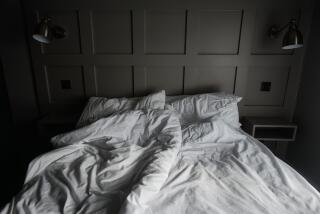Springing ahead to a long March
- Share via
Daylight saving time begins three weeks earlier this year and lasts one week longer -- welcome news for people who relish the extra afternoon light to garden, ride a bicycle, walk the dog or just take out the trash when they can still see the curb.
But the extension, which begins Sunday, could actually make millions of Americans feel less sunny. For those people -- suffering from seasonal affective disorder or its milder cousin, winter blues -- the corresponding reduction in morning light may worsen or lengthen their depression, doctors and mood experts say. “We’re very worried about it,” says Michael Terman, director of New York-Presbyterian Hospital’s Center for Light Treatment and Biological Rhythms. “It’s the early morning light exposure that allays the symptoms of winter depression. The later the sun rises, the more likely we are to get depressed.”
Early morning light sets the body’s clock to gear up for the day’s activities, but the later sunrise in the winter -- and a society based on the clock instead of nature -- causes a delay in the normal cycle, says Terman. For some people, this can lead to winter-induced depression, known as seasonal affective disorder.
Such depression usually creeps up in late fall, slams down hard in January and February and lifts in early May. Besides a poor mood, symptoms include low energy, problems sleeping, fatigue, weight gain, reduced concentration and increased appetite, especially for carbohydrates.
Most people with the condition feel their normal selves in the summer months.
“In the summer, these same people are dynamos,” says Dr. David H. Avery, a professor of psychiatry and behavioral sciences at the University of Washington.
About 3% to 5% of Americans are thought to have seasonal affective disorder, says Terman, although it’s far more common in the northern latitudes than in the Sunbelt. An additional 15% to 20% of people experience a lesser form of the disorder, called winter doldrums or winter blues. They are not diagnosed with clinical depression, but they clearly don’t feel as chipper in the winter months.
Even the residents of sunny Southern California are not immune. Byron Acevedo, 36, says he feels depression coming on each October. “It’s amazing how it affects me,” says the computer technician, who works in Glendale. “I realize the days are getting cold and dark. I just feel sad.”
Acevedo battles the condition by turning on lots of bright lights in his house whenever it’s dark outside and by reminding himself that the gloom will lift in the spring. Like many fans of summer, he hopes the earlier start to daylight saving time might make him feel better sooner this year.
Some doctors say that seems unlikely.
Moving up the clocks by one hour will mean more dark mornings in March and again in early November, says Avery. People with winter depression may feel as if they’re stuck in February.
“In Seattle, for example, the effect would be that in early March the clock would spring ahead and sunrise will be occurring at about 7:31 a.m., similar to the time on Feb. 5,” he says. “Such a change not only will affect people with winter depression but also will probably lead to increased drowsiness in the morning commute and an increase in traffic accidents.”
*
Out of sync
The daylight saving time extension was authorized by Congress in 2005 largely to save energy. There was little discussion of the effect on mood, although some mental health experts -- including Avery -- wrote to Congress before its 2005 vote warning lawmakers not to mess with the nation’s mood.
Over the last two decades, researchers point out, they’ve developed a greater understanding of the role of circadian rhythms in the human body.
These rhythms -- which govern the body’s natural cycles, regulating appetite, sleep and mood -- are controlled in large part by light. In response to this natural cue, the body releases various hormones and neurotransmitters, increases body temperature and boosts blood pressure. Sunset cues the body to wind down, lowering blood pressure and increasing melatonin, the body’s sleep hormone.
Research shows it’s the delay in sunrise -- not the overall hours of sunlight -- that has the biggest effect on mood during winter. People in the north have more depression, but so do people who live on the western edge of each time zone -- where the sun rises later.
“People waking up at the western edge are much more likely to be waking up in darkness,” Terman says.
It’s unnatural to wake up in the dark, says Avery. But modern lifestyles have taken Mother Nature out of the equation.
“For millions of years our ancestors had a regular sunrise time on a day-to-day basis,” he says. “In a sense, our bodies and brains are designed to deal with that. Electric light led us to have erratic light-dark signals. And we end up -- surprise -- feeling worse.”
*
Light is the best therapy
Although most people with winter depression or winter blues go undiagnosed, the condition can be treated with antidepressants or light therapy, says Paul Arbisi, a clinical psychologist at the Minneapolis Veterans Administration Medical Center. Light therapy, or phototherapy, involves sitting under bright, artificial light emitted from a box or lamp for about 30 minutes a day -- usually in the morning. Such treatment helps about 60% to 70% of people with seasonal affective disorder or winter doldrums.
In a newer type of light therapy, called dawn simulation, lamps or light boxes come on automatically and gradually increase light intensity in the home -- mimicking a natural dawn.
“There are effective treatments that are well-accepted,” says Arbisi. “Nobody needs to go through a winter depressed any longer.”
Although Congress’ action has created something of a population-wide psychiatric experiment, Arbisi believes the effect will be minimal. “By this time of year most people are experiencing a remission,” he says. “My gut feeling is that three weeks is not going to make that much of a difference.”
Other mental health experts say people who expect to start feeling better by the end of March will be especially dismayed that they still feel depressed.
“I think it’s a bad move,” says Avery of the time change. “The lobby on the other side that was pushing for this are people who wanted more light after work. I’m sympathetic to that. But that’s not in the best interests of society.”
*
*
(BEGIN TEXT OF INFOBOX)
SAD or blue?
Determining whether you have seasonal affective disorder, a milder version called winter doldrums or some other type of mood disorder depends on the severity of your symptoms, when they occur and how predictable this pattern is from year to year.
The Center for Environmental Therapeutics, a nonprofit network of doctors and researchers who study seasonal affective disorder, has created a questionnaire to help diagnose the condition at www.cet.org.
The website also features a questionnaire that can determine your circadian rhythm type -- if you are a “morning” person or an “evening” person. Knowing your circadian rhythm can help you schedule light therapy at the most effective time of day if you have depression or simply suggest the optimal time for you to go to bed.


